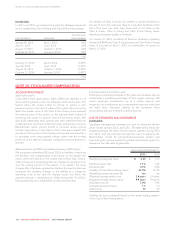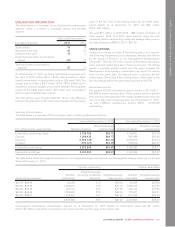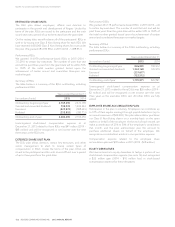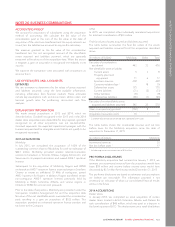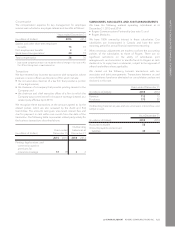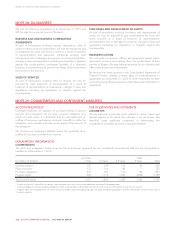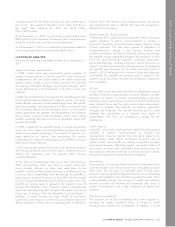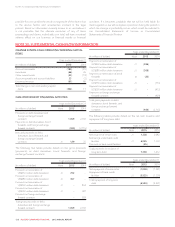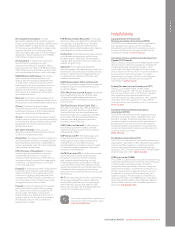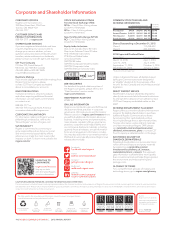Rogers 2015 Annual Report Download - page 142
Download and view the complete annual report
Please find page 142 of the 2015 Rogers annual report below. You can navigate through the pages in the report by either clicking on the pages listed below, or by using the keyword search tool below to find specific information within the annual report.140 ROGERS COMMUNICATIONS INC. 2015 ANNUAL REPORT
Glossary of Selected Industry Terms
and Helpful Links
3G (Third Generation Wireless): The third
generation of mobile phone standards and
technology. A key aim of 3G standards was to
enable mobile broadband data speeds above
384 Kbps. 3G networks enable network operators
to offer users a wider range of more advanced
services while achieving greater network capacity
through improved spectral efficiency. Advanced
services include video and multimedia messaging
and broadband wireless data, all in a mobile
environment.
3.5G (Enhanced Third Generation Wireless):
Evolutionary upgrades to 3G services that
provide significantly enhanced broadband
wireless data performance to enable multi-
megabit data speeds. The key 3.5G technologies
in North America are HSPA and CDMA EV-DO.
4G (Fourth Generation Wireless): A technology
that offers increased voice, video and multimedia
capabilities, a higher network capacity, improved
spectral efficiency, and high-speed data rates over
current 3G benchmarks.
4K - Ultra-High Definition Video: Denotes
a specific television display resolution of
4096 x 2160 pixels. 1920 x 1080 resolution full
HD televisions present an image of around
2 megapixels, while the 4K generation of screens
delivers an 8 megapixel image.
ARPA (Average Revenue per Account): This
business performance measure expressed as a
dollar rate per month includes all the revenue
generated by an account as opposed to a user or
device so that a customer who has many devices
will typically have a higher ARPA than a customer
with only one device.
ARPU (Average Revenue per User): This business
performance measure, expressed as a dollar rate
per month, is predominantly used in the wireless
and cable industries to describe the revenue
generated per customer per month. ARPU is an
indicator of a wireless or cable business’ operating
performance.
AWS (Advanced Wireless Services): The wireless
telecommunications spectrum band that is
used for wireless voice, data, messaging services,
and multimedia.
Bandwidth: Bandwidth can have two different
meanings: (1) a band or block of radio frequencies
measured in cycles per second, or Hertz; (2) an
amount or unit of capacity in a telecommunications
transmission network. In general terms, bandwidth
is the available space to carry a signal. The greater
the bandwidth, the greater the information-
carrying capacity.
Bps (Bits per Second): A measurement of data
transmission speed used for measuring the amount
of data that is transferred in a second between
two telecommunications points or within network
devices. Kbps (kilobits per second) is thousands of
bps; Mbps (megabits per second) is millions of bps;
Gbps (gigabits per second) is billions of bps; and
Tbps (terabits per second) is trillions of bps.
BYOD (Bring Your Own Device): Refers to the
action that customers are able to sign up for
wireless services on a personally purchased device
as opposed to the traditional means of acquiring
one through a term contract.
Broadband: Communications services which
allows for the high-speed transmission of voice,
data, and video simultaneously at rates of 1.544
Mbps and above.
BDU (Broadcast Distribution Undertaking):
An undertaking for the reception of broadcasting
and the retransmission thereof by radio waves or
other means of telecommunication to more than
one permanent or temporary residence or dwelling
unit or to another such undertaking.
Cable Telephony (Phone): The transmission of real-
time voice communications over a cable network.
Churn: This business performance measure is
used to describe the disconnect rate of customers
to a telecommunications service. It is a measure
of customer turnover and is often at least partially
reflective of service quality and competitive
intensity. It is usually expressed as a percentage
and calculated as the number of subscriber units
disconnecting in a period divided by the average
number of units on the network in the same period.
CLEC (Competitive Local Exchange Carrier):
A telecommunications provider company that
competes with other, already established carriers,
generally the ILEC.
Cloud Computing: The ability to run a program
or application on many connected computers
simultaneously as the software, data and services
reside in data centres.
CRTC (Canadian Radio-television and
Telecommunications Commission): The federal
regulator for radio and television broadcasters
and cable TV and telecommunications
companies in Canada.
CPE (Customer Premise Equipment):
Telecommunications hardware, such as modems
or set-top boxes, that is located at the home or
business of a customer.
Data Centre: A facility used to house computer
systems and associated components, such
as telecommunications and storage systems.
It generally includes redundant or backup
power supplies, redundant data communications
connections, environmental controls (e.g., air
conditioning, fire suppression), and security
controls.
DOCSIS (Data Over Cable Service Interface
Specification): A non-proprietary industry standard
developed by CableLabs that allows for equipment
interoperability from the headend to the CPE. The
latest version (DOCSIS 3.0/3.1) enables bonding of
multiple channels to allow for 250 Mbps or greater
transmission speeds depending upon how many
channels are bonded together.
DSL (Digital Subscriber Line): A family of
broadband technologies that offers always-on,
high-bandwidth (usually asymmetrical) transmission
over an existing twisted-pair copper telephone line.
DSL shares the same phone line as the telephone
service but it uses a different part of the phone
line’s bandwidth.
Fibre Optics: A method for the transmission of
information (voice, video or data) in which light is
modulated and transmitted over hair-thin filaments
of glass called fibre optic cables. The bandwidth
capacity of fibre optic cable is much greater than
that of copper wire and light can travel relatively
long distances through glass without the need
for amplification.
FTTH (Fibre-to-the-Home): Represents fibre optic
cable that reaches the boundary of the living space,
such as a box on the outside wall of a home.
GSM (Global System for Mobile): A TDMA-
based technology and a member of the “second
generation” (2G) family of mobile protocols that is
deployed widely around the world, especially at the
850, 900, 1800, and 1900 MHz frequency bands.
HDR (High Dynamic Range): An imaging
technique used to reproduce a greater dynamic
range of luminosity than is possible with standard
digital imaging or photographic techniques.
Homes Passed: Total number of homes which have
the potential for being connected to a cable system
in a defined geographic area.
Hosting (Web Hosting): The business of housing,
serving, and maintaining files for one or more
websites or email accounts. Using a hosting
service allows many companies to share the cost
of a high-speed Internet connection for serving
files, as well as other Internet infrastructure and
management costs.
Hotspot: A Wi-Fi access point in a public place
such as a café, train station, airport, commercial
office property, or conference centre.
HSPA (High Speed Packet Access): HSPA is an
IP-based packet-data enhancement technology
that provides high-speed broadband packet data
services over 3G networks. HSPA+ provides high-
speed broadband packet data services at even
faster speeds than HSPA over 4G networks.
HUP (Hardware Upgrade): When an existing
wireless customer upgrades to a new wireless
device, this is referred to as a HUP or Hardware
UPgrade.
ILEC (Incumbent Local Exchange Carrier): The
dominant telecommunications company providing
local telephone service in a given geographic
area when competition began. Typically an ILEC is
the traditional phone company and original local
exchange carrier in a given market.
ISED Canada (Innovation, Science and Economic
Development Canada): The Canadian federal
government department responsible for, amongst
other things, the regulation, management, and
allocation of radio spectrum and establishing
technical requirements for various wireless systems.
IP (Internet Protocol): The packet-based computer
network protocol that all machines on the Internet
must know so they can communicate with one
another. IP is basically a set of data switching and
routing rules that specify how information is cut
up into packets and how they are addressed for
delivery between computers.
IPTV (Internet Protocol Television): A system
where a digital television signal is delivered using
Internet Protocol. Unlike broadcasting, viewers
receive only the stream of content they have
requested (by surfing channels or ordering video
on demand).
ISP (Internet Service Provider): A provider
of Internet access service to consumers
and/or businesses.
LAN (Local Area Network): A network
created via linked computers within a small
area, such as a single site or building.


